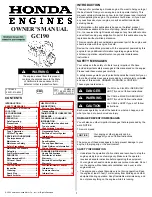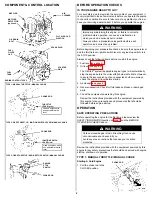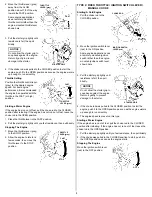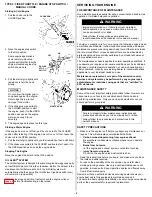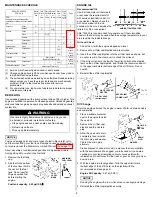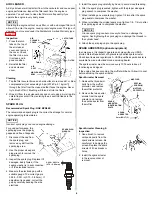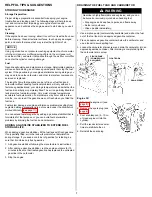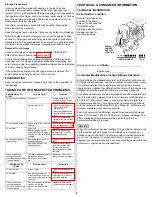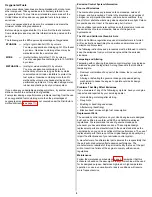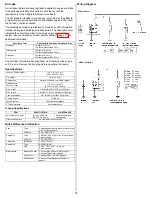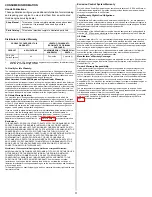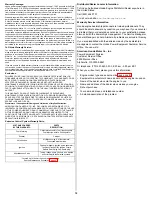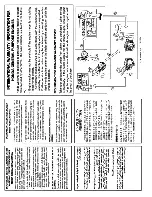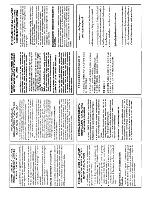
8
Storage Precautions
If your engine will be stored with gasoline in the fuel tank and
carburetor, it is important to reduce the hazard of gasoline vapor
ignition. Select a well-ventilated storage area away from any appliance
that operates with a flame, such as a furnace, water heater, or clothes
dryer. Also avoid any area with a spark-producing electric motor, or
where power tools are operated.
If possible, avoid storage areas with high humidity, because that
promotes rust and corrosion.
Keep the engine level in storage. Tilting can cause fuel or oil leakage.
With the engine and exhaust system cool, cover the engine to keep
out dust. A hot engine and exhaust system can ignite or melt some
materials. Do not use sheet plastic as a dust cover. A nonporous cover
will trap moisture around the engine, promoting rust and corrosion.
Removal From Storage
Check your engine as described in the
BEFORE OPERATION
CHECKS
section of this manual (see page 2).
If the fuel was drained during storage preparation, fill the tank with
fresh gasoline. If you keep a container of gasoline for refueling, be
sure it contains only fresh gasoline. Gasoline oxidizes and deteriorates
over time, causing hard starting.
If the cylinder was coated with oil during storage preparation, the
engine will smoke briefly at startup. This is normal.
TRANSPORTING
Keep the engine level when transporting to reduce the possibility of
fuel leakage.
TAKING CARE OF UNEXPECTED PROBLEMS
TECHNICAL & CONSUMER INFORMATION
TECHNICAL INFORMATION
Serial Number Location
Record the engine serial
number in the space
below. You will need this
information when
ordering parts and when
making technical or
warranty inquiries.
Engine serial number:
GCAAA–
___ ___ ___ ___ ___ ___ ___
Engine type: ___ ___ ___ ___
Carburetor Modifications for High Altitude Operation
At high altitude, the standard carburetor air-fuel mixture will be too rich.
Performance will decrease, and fuel consumption will increase. A very
rich mixture will also foul the spark plug and cause hard starting.
Operation at an altitude that differs from that at which this engine was
certified, for extended periods of time, may increase emissions.
High altitude performance can be improved by specific modifications to
the carburetor. If you always operate your trimmer at altitudes above
5,000 feet (1,500 meters), have your servicing dealer perform this
carburetor modification. This engine, when operated at high altitude
with the carburetor modifications for high altitude use, will meet each
emission standard throughout its useful life.
Even with carburetor modification, engine horsepower will decrease
about 3.5% for each 1,000-foot (300-meter) increase in altitude. The
effect of altitude on horsepower will be greater than this if no
carburetor modification is made.
NOTICE
When the carburetor has been modified for high altitude operation, the
air-fuel mixture will be too lean for low altitude use. Operation at
altitudes below 5,000 feet (1,500 meters) with a modified carburetor
may cause the engine to overheat and result in serious engine
damage. For use at low altitudes, have your servicing dealer return the
carburetor to original factory specifications.
ENGINE WILL NOT
START
Possible Cause
Correction
1. Check control positions
Choke open.
Pull the choke to the
CLOSED position unless
the engine is warm.
Ignition switch OFF.
the SLOW or FAST
position (p.3).
lever to the ON position
(p. 3).
switch to the ON position
(p. 4).
2. Check engine oil level.
Engine oil level low (Oil Alert
models).
Fill with the recommended
oil to the proper level (p. 5).
3. Check fuel.
Out of fuel.
Refuel.
Bad fuel; engine stored
without treating or draining
gasoline, of refueled with bad
gasoline.
Drain the fuel tank and
carburetor (p. 7). Refuel
with fresh gasoline.
4. Remove and inspect
spark plug.
Spark plug faulty, fouled, or
improperly gapped.
Spark plug wet with fuel
(flooded engine).
Dry and reinstall spark
plug. Start engine with
throttle lever in FAST
position (choke in OPEN
position).
5. Take engine to an
authorized Honda
servicing dealer, or refer
to shop manual.
Fuel filter clogged, carburetor
malfunction, ignition
malfunction, valves stuck,
etc.
Replace or repair faulty
components as necessary.
ENGINE LACKS
POWER
Possible Cause
Correction
1. Check air filter
Filter clogged.
Clean or replace the filter
(p. 6).
2. Check fuel.
Bad fuel; engine stored
without treating or draining
gasoline, of refueled with bad
gasoline.
Drain the fuel tank and
carburetor (p. 7). Refuel
with fresh gasoline.
3. Take engine to an
authorized Honda
servicing dealer, or refer
to shop manual.
Fuel filter clogged, carburetor
malfunction, ignition
malfunction, valves stuck,
etc.
Replace or repair faulty
components as necessary.
SERIAL
NUMBER
AND TYPE
LOCATION
SERIAL NUMBER
TYPE

